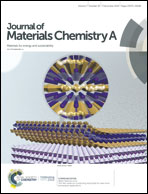2.5 V salt-in-water supercapacitors based on alkali type double salt/carbon composite anode†
Abstract
Due to the advantages of safe, cost-effective and environment friendly, aqueous high-voltage carbon/carbon supercapacitors attract much attention but the poor cycling stability hinders their practical applications. In this study, by electrodepositing a Zn/Zn4SO4(OH)6·4H2O (ATDS) composite on a microporous carbon cloth modified with basic functional groups (OCC) as a negative electrode, we developed an aqueous carbon/carbon supercapacitor operating steadily at a voltage as high as 2.5 V. The ATDS composite expands the negative potential window of carbon to −1.7 V vs. SCE and thus makes the positive carbon cloth (CC) operate in the stable potential range to inhibit the capacity degradation of the supercapacitor. A 2.1 V beaker-shaped supercapacitor of ATDS@OCC//CC presents almost 100% capacity retention after 19 000 cycles at 18 mA cm−2. Moreover, the cycled 2.1 V ATDS@OCC//CC supercapacitor exhibits the improved energy density of 9 mW h cm−3 and better retention of the energy density. A 2.5 V ATDS@OCC//CC supercapacitor after 4900 cycles exhibits about 100% capacity retention, an ultrahigh volumetric energy density of 20 mW h cm−3 and a mass energy density of 29 W h kg−1. The novel strategy may pave the way for developing safe, environment friendly and high-energy carbon/carbon supercapacitors.



 Please wait while we load your content...
Please wait while we load your content...